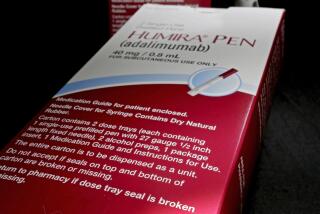Drug Discount Cards for Seniors Not Relieving Pain of High Prices
- Share via
Bonita Harrison takes so many medications that she has to keep a list. There’s Premarin for estrogen replacement therapy, Aciphex for heartburn and Nasonex for allergies. There’s Flovent, albuterol and Triam-A for asthma. She also takes Fergon as an iron supplement and prednisone to supplement her cortisone production.
Harrison manages to pay for all this on her $15,000 annual income by using generics whenever she can. But when her doctor told her she also needed the Merck & Co. blood pressure drug Cozaar, she was looking at paying as much as $56 a month, the full retail price.
The 62-year-old Hawthorne resident seems a perfect candidate for one of the drug discount cards being offered to seniors. But Merck is not one of the seven pharmaceutical companies that will participate in the Together Rx card, which would reduce prices by 20% to 40% on more than 150 medicines for low-income Medicare enrollees who lack drug coverage. Merck’s own free-drugs program for low-income people can’t help her either--it’s only for those with no drug coverage. And Harrison’s PacifiCare HMO prescription plan won’t cover Cozaar.
“I guess people expect us to walk from the job to the grave and skip retirement,” Harrison said.
Harrison’s problem illustrates why many critics say the pharmaceutical industry’s highly touted drug discount cards and free-drugs plans offer little or no help to the majority of older Americans who are struggling with the sharp rise in prescription medicine prices.
The Medicare program, which serves about 39 million Americans, does not pay for prescription drugs purchased at pharmacies. Many Medicare recipients get medicine coverage through their HMO plans, but about 11 million have no HMO coverage.
Several health plans, coping with rising costs as doctors and hospitals demand higher pay for their services, have made deep cuts in their prescription benefits or have pulled out of some regions, increasing the ranks of the underinsured.
Pharmaceutical companies and supporters of discount cards acknowledge that the discount card programs are a limited, interim measure.
“It can’t take the place of Medicare modernization that includes meaningful prescription drug coverage,” Johnson & Johnson spokesman Mark Monseau said.
“These discount cards will help some people save a little money,” said John Rother, legislative director for the AARP, which supports the Together Rx program announced April 10 by GlaxoSmithKline, Bristol-Myers Squibb Co., Novartis, Abbott Laboratories, Aventis, Johnson & Johnson and AstraZeneca. Rother likened the hundreds of other discount drug cards already on the market to “frequent flier programs--good marketing but not always the greatest deal.”
Others were more blunt.
“There is a case to be made that this is more of a public relations issue than getting folks the drugs they need,” said Amanda McCloskey, director of health policy for the Families USA Foundation in Washington. “This really isn’t the answer.”
Both supporters and critics of the pharmaceutical industry agree on one point: Congress must pass and the president must sign Medicare reform legislation that will make it easier for all seniors to get the medications they need.
But estimates of the cost of such a program over 10 years range from $350 billion to as much as $800 billion.
“It’s going to cost a lot more than anyone suspects,” said Jack Lewin of the California Medical Assn., noting that there also is pressure on Congress to raise pay rates for doctors who treat Medicare patients, particularly in California.
Something must be done in the interim, and drug discount cards and other forms of discounted prices aren’t enough, critics say. They point to an extraordinary four-year series of prescription spending increases of at least 17% a year.
At least one-third of the 2001 drug-spending increase came from higher prices, said the National Institute for Health Care Management, with the rest coming from greater overall demand for drugs and patients switching to more expensive brands.
Critics also question pharmaceutical companies’ sincerity in offering price breaks because the industry is being sued by several states for alleged price-fixing schemes.
Some health plans and the Federal Trade Commission also charge that the industry conspires to keep lower-cost generics off the market.
Now, a bipartisan group of U.S. senators from Northern border states is sponsoring a bill that would help Americans save as much as $38 billion a year by allowing prescription drug sales through Canada, where tight controls have reined in prices.
The pharmaceutical industry defends its pricing with research on the costs of bringing medications to market. A December study by the Tufts Center for the Study of Drug Development said the cost of developing the average drug rose from $231 million in 1987 to $802 million in 2000.
Representatives of the companies participating in Together Rx, such as GlaxoSmithKline spokeswoman Mary Anne Rhyne, call their plan “a noble effort” that was supported by several governors, members of Congress and organizations such as the National Council on the Aging.
Rhyne said 55,000 people have signed up for GlaxoSmithKline’s Orange Card for drug discounts since it was rolled out in January. Rhyne said Orange Card holders were averaging savings of 30% on their drug costs, and that the Together Rx card is expected to provide similar savings.
Pfizer Inc., the nation’s largest drug maker, says its Pfizer for Living Share Card plan has generated even more interest, enrolling 80,000 in its first three months. For low-income people without drug coverage, the Share Card offers a 30-day supply of any Pfizer drug for a $15 fee that goes toward the cost of distribution.
Pfizer Chief Executive Hank McKinnell scoffed at the notion that his company’s program won’t help many seniors, saying in an interview that “there are about 7 million Americans who can be helped by this program.”
Critics say generic versions of brand name products often are cheaper than the discounted prices. Some cards have monthly fees, aren’t honored by some pharmacies and won’t cover all the drugs the patient needs. And the “up to 65%” savings that some advertise is a pipe dream.
“A lot of the time the discount [price] is higher than our regular senior discount price,” said John Tilly, an independent pharmacy owner of the Zweber Apothecary in Downey and 14 other locations. “A lot of times they don’t really save the patient money, but the patient is paying a monthly fee to keep their card active.”
Some older Americans, such as Dan and Rita Cohn, say their needs were too immediate to wait for congressional or drug industry relief.
The Cohns, of Hollywood, Fla., had a modest retirement dream of traveling the nation in their motor home. Instead, the treasured vehicle is up for sale. “We spent $4,700 on prescription drugs last year,” Rita Cohn said. “It was either the motor home or the drugs. It has come to that.”
Their combined income exceeds the Together Rx card’s $38,000 income limit for couples. Their Medicare HMO drug coverage has been slashed. Now, Dan Cohn, a 73-year-old Army veteran, has resorted to the local veterans center, where he has a $7 co-pay for his medications.
“I’m a real flag-waver now,” he said.
Rita Cohn, 70, has turned to Canadian pharmacies that will accept her six prescriptions by fax and mail the drugs back. She said a one-month supply of Pfizer’s cholesterol drug Lipitor from Canada costs $70, well below the $110 she pays locally.
“This is why I’m so crazy about Canada,” she said.
But Helen Cecil, who lives on a fixed income of $1,000 a month in Paramount, is among the most desperate. Her trailer park rent costs her $421 a month. She gets a bit of a break on her cholesterol, hypertension and arthritis medications from a low-cost mail-order company, but she still spends $150 a month on drugs.
She can’t get a price break on Lipitor through Pfizer’s discount program, in part because Lipitor isn’t covered by her HMO. With the help of the Center for Health Care Rights in Los Angeles, Cecil hopes to find another HMO that includes her doctor and covers Lipitor.
In the meantime, Cecil gets free samples from her doctor, but she knows that can’t last.
“If I have to pay for all of it, I’ll have to cut down on food or something,” she said.
(BEGIN TEXT OF INFOXBOX)
A Full Deck of Discount Drug Cards
Together RX Card
Companies: GlaxoSmithKline, Bristol-Myers Squibb Co., Novartis, Abbott Laboratories, Aventis, Johnson & Johnson, AstraZeneca
Information: (800) 865-7211
Announced: April 2002
Roll-out: June 2002
Benefits: Purported savings of 20% to 40% on 130 to 150 brand name drugs produced by the companies.
Fees: None
Eligibility: For Medicare recipients with no prescription drug coverage. Income less than $28,000 annually for singles, $38,000 for couples.
Orange Card
Company: GlaxoSmithKline
Information: (888) 672-6436
Announced: October 2001
Roll-out: January 2002
Cardholders: 55,000
Benefits: Purported savings of 30%, on average, on a variety of the company’s drugs.
Fees: None
Eligibility: Annual income at or below $26,000 (singles) and $35,000 (couples). Cannot have public or private insurance or other drug benefit programs, such as Medicaid.
Living Share Card
Company: Pfizer
Information: (800) 717-6005
Announced: January 2002
Roll-out: January 2002
Cardholders: 80,000
Benefits: Low-income and disabled Medicare recipients can get any Pfizer drug for $15 a month.
Eligibility: Unless disabled, annual income must be less than $18,000 for singles, $24,000 for couples.
LillyAnswers Card
Company: Eli Lilly
Information: (877) RXLILLY
Announced: March 2002
Roll-out: March 2002
Cardholders: Not available
Benefits: Low-income and disabled Medicare recipients can buy most Lilly prescription products and insulin for $12.
Eligibility: Annual income must be less than $18,000 for singles or $24,000 for couples. Must not have any other prescription drug coverage.
Merck Patient Assistance Program
Company: Merck & Co.
Information: (800) 727-5400
Roll-out: 50 years ago
Participants: 350,000
Benefits: Free medications shipped directly to homes for up to one year; all Merck products except vaccines and injectable drugs.
Eligibility: Any patient of any age who lacks drug coverage. Income must be less than $18,000 for singles and less than $24,000 for a household.
Walgreens Senior Dividends Card
Company: Walgreens
Information: Available at any Walgreens pharmacy.
Announced: March 2002
Roll-out: March 2002
Cardholders: Not available
Benefits: Technically not a discount card. A 10% rebate on the price of the drug purchased is added to the card, which can be used for purchases at Walgreens.
Fees: None
Eligibility: For people 55 and older who don’t have drug coverage and don’t participate in a government assistance plan.
AARP Prescription Savings Card
Organization: AARP
Information: (800) 289-6031
Roll-out: 1959
Participants: 3.5 million enrolled in Health Care Options
Benefits: Savings of 15% on brand-name drugs and 50% to 55% on mail-order generics.
Eligibility: AARP members and their spouses.
Sources: Pharmaceutical companies, Walgreens, AARP
More to Read
Inside the business of entertainment
The Wide Shot brings you news, analysis and insights on everything from streaming wars to production — and what it all means for the future.
You may occasionally receive promotional content from the Los Angeles Times.











